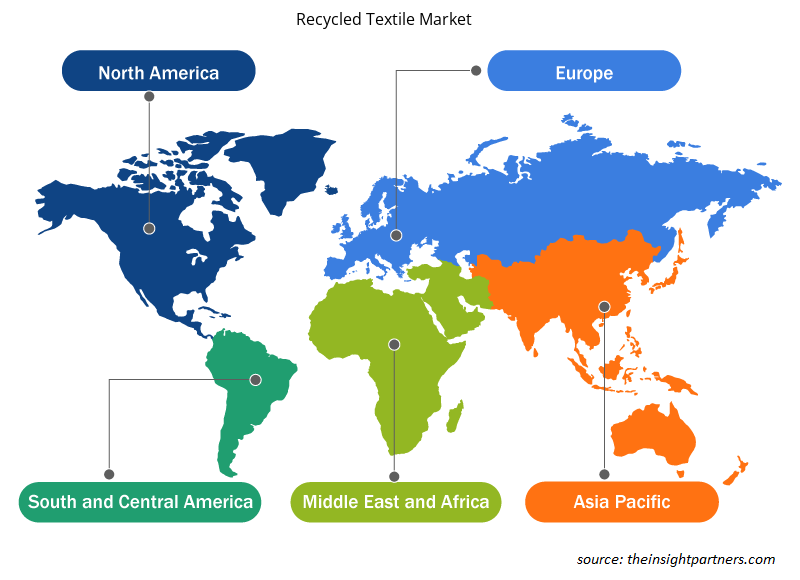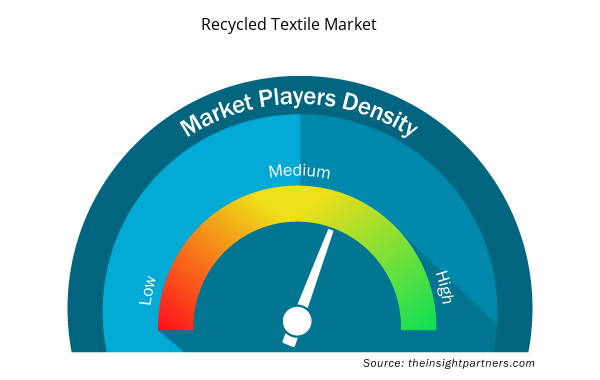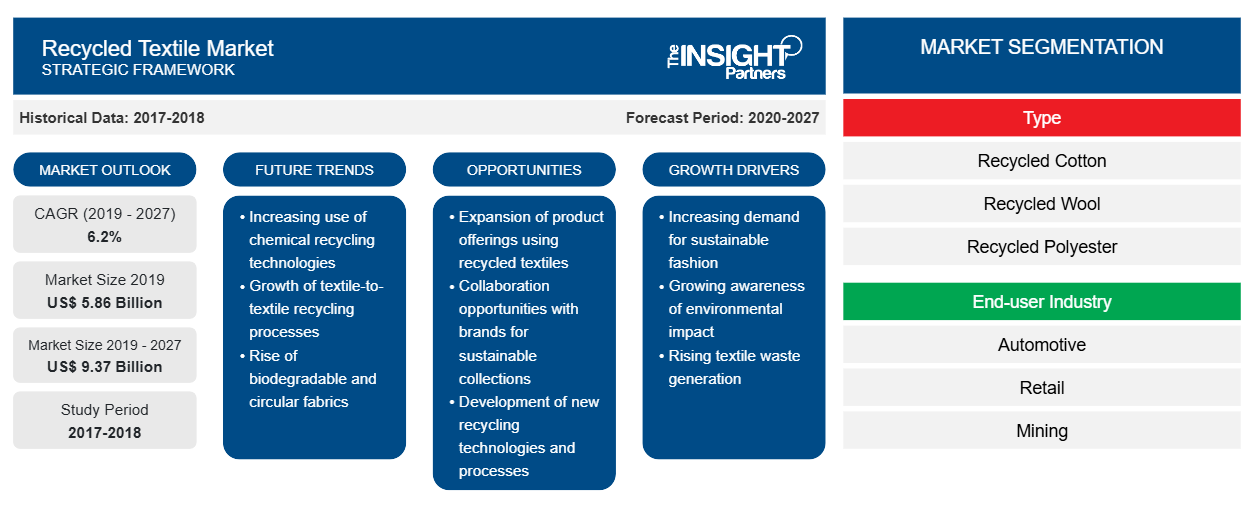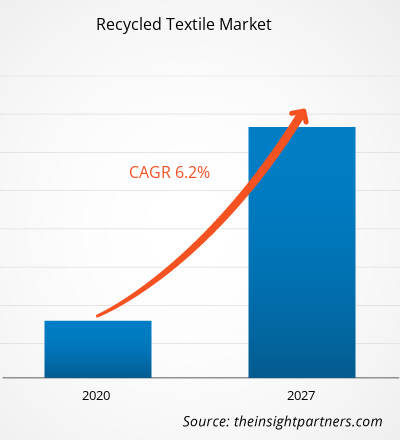2019 年再生纺织品市场价值为 58.5539 亿美元,预计到 2027 年将达到 93.6504 亿美元;预计 2020 年至 2027 年的复合年增长率为 6.2%。
再生纺织品是指旧衣服或其他未使用的纺织品,可以回收再利用或材料回收。近年来,人们越来越担心全球纺织废料的处理可能会对环境产生负面影响。全球对再生纺织品的需求正在上升,服装、面料、汽车等多个终端使用行业的需求激增。制造商采用多种技术将旧纺织品回收成更好的产品,这些产品可用于各种终端使用行业。资源回收主要借助热、机械和化学技术。
由于欧洲政府不断推出举措,欧洲已成为再生纺织品的重要市场。此外,汽车行业对再生纺织品产品的需求不断增长,为在该市场运营的再生纺织品市场参与者提供了有利可图的机会。购买力的提高加上生活方式的改变是欧洲地区纺织品市场增长的主要驱动因素之一。在欧洲,近 15% 的消费者旧衣服被回收,而超过 75% 的二手衣服被制造商回收用于工业用途。过去几年,欧洲对再生纺织品的需求以最高速度增长。再生纺织品生产商主要关注德国、英国等国家,这导致欧洲地区对再生纺织品的需求巨大。消费者对循环纺织经济的日益关注也有望在更大程度上推动该地区的市场增长。
截至 2020 年 8 月,就确诊病例和报告死亡人数而言,美国、巴西、印度、俄罗斯、南非、墨西哥、西班牙和英国是受影响最严重的国家。由于封锁、旅行禁令和企业停工,COVID-19 已影响到各国的经济和行业。全球化学和材料行业是遭受严重破坏的主要行业之一,例如由于 COVID-19 爆发而导致的供应链中断、制造中断。例如,中国是全球制造业中心,也是各行业最大的原材料供应国。中国以及亚太地区和欧洲等主要地区的多家工厂的封锁正在影响全球供应链,并对各种商品的制造、交货时间表和销售产生负面影响。所有这些因素都极大地影响了全球再生纺织品市场。
定制此报告以满足您的需求
您可以免费定制任何报告,包括本报告的部分内容、国家级分析、Excel 数据包,以及为初创企业和大学提供优惠和折扣
- 获取此报告的关键市场趋势。这个免费样品将包括数据分析,从市场趋势到估计和预测。
市场洞察
纺织废料处理问题日益令人担忧
纺织制造机制被认为是化学密集型工艺之一,在整个操作过程中会产生大量纺织废料。纺织废料可分为两类:消费前纺织废料和消费后纺织废料。纺织废料数量的增加给环境带来了负担,并产生了现有垃圾填埋场的有效处置或焚烧问题。据估计,所有未使用的纺织品中约有 10-20% 被视为浪费。例如,根据美国环保署的数据,2015 年,共有 1575 万吨纺织品作为城市固体废物产生,其中 19% 被焚烧,而 65% 则被填埋。此外,美国环境保护署的一份报告指出,纺织品的生产和处置会导致温室气体排放。此外,焚烧过程会排放有机物质,如重金属、二恶英、酸性气体和灰尘颗粒,这些物质被认为对人类和环境都有害。此外,处理残留灰烬也已成为一个严重问题,因为其中也含有高浓度的有毒物质。因此,通过再利用或回收方法有效管理纺织废料是十分必要的,这可以促进环境的可持续性。在这种情况下,回收纺织废料被认为是一种可行的替代方案,有助于减轻自然资源的负担,最大限度地减少对垃圾填埋场空间的需求,并有助于节约能源。此外,政府出台的严格立法规范纺织废料的有效管理,可能旨在促进使用纺织品回收作为一种可持续的替代方案,以解决与废物有关的迫在眉睫的问题。
类型洞察
根据类型,再生纺织品市场细分为再生棉、再生羊毛、再生聚酯、再生尼龙等。再生尼龙部分预计将在 2019-2027 年的预测期内以最快的速度增长。再生尼龙由工业塑料、废纤维、织布厂的废弃物和消费后渔网制成。它们被再生成新的尼龙,其质量与原生尼龙相同。尼龙袋、尼龙织物和尼龙地毯也被转化为再生尼龙以供进一步使用。大部分再生尼龙来自渔网。它是转移海洋垃圾的绝佳解决方案。与尼龙相比,回收尼龙是一种昂贵的工艺,但它具有许多环境效益。通过回收尼龙,可以消除废弃物并减少制造过程中的温室气体排放量。它减少了对石油作为原材料来源的依赖。使用再生尼龙还有助于促进不再使用的尼龙产品的新回收流。大多数机械回收材料在高温下熔化,最终会破坏污染物并将材料转化为可重复使用的形式。尼龙在回收时在低温下熔化,留下污染物。因此,尼龙在回收前需要仔细清洁。
最终用户行业洞察
根据最终用户行业,再生市场细分为汽车、零售、采矿和其他。预计在 2019-2027 年的预测期内,汽车行业将以最快的速度增长。再生纺织品用于汽车工业,在汽车零部件的生产中贡献巨大。再生纺织品在汽车应用中的用途包括可见部件,如地板覆盖物、室内装饰、安全带,以及不可见的再生纺织品,如管子和胶带、轮胎帘线、安全气囊组件和纤维。再生纺织品因其抗拉强度、耐磨性、透气性、抗压性、弹性、易于清洁、阻燃性和耐动态气候条件性而用于汽车工业。再生棉用于座椅填充物或汽车隔热材料。
Anandi Enterprises、Chindi、Khaloom Textile India Pvt. Ltd.、Kishco Group 等是全球再生纺织品市场的主要参与者。这些公司正在实施新产品开发和并购战略,以扩大客户群并在全球范围内获得显著的市场份额,这反过来又使参与者能够在全球范围内维护其品牌名称。
再生纺织品市场区域洞察
Insight Partners 的分析师已详细解释了预测期内影响再生纺织品市场的区域趋势和因素。本节还讨论了北美、欧洲、亚太地区、中东和非洲以及南美和中美洲的再生纺织品市场细分和地理位置。

- 获取再生纺织品市场的区域特定数据
再生纺织品市场报告范围
| 报告属性 | 细节 |
|---|---|
| 2019 年市场规模 | 58.6亿美元 |
| 2027 年市场规模 | 93.7亿美元 |
| 全球复合年增长率(2019 - 2027) | 6.2% |
| 史料 | 2017-2018 |
| 预测期 | 2020-2027 |
| 涵盖的领域 | 按类型
|
| 覆盖地区和国家 | 北美
|
| 市场领导者和主要公司简介 |
|
市场参与者密度:了解其对商业动态的影响
再生纺织品市场正在快速增长,这得益于终端用户需求的不断增长,而这些需求又源于消费者偏好的不断变化、技术进步以及对产品优势的认识不断提高等因素。随着需求的增加,企业正在扩大其产品范围,进行创新以满足消费者的需求,并利用新兴趋势,从而进一步推动市场增长。
市场参与者密度是指在特定市场或行业内运营的企业或公司的分布情况。它表明在给定市场空间中,相对于其规模或总市场价值,有多少竞争对手(市场参与者)存在。
在再生纺织品市场运营的主要公司有:
- 钦迪语
- Khaloom 纺织印度私人有限公司
- 吉实集团
- 乌莎纱线有限公司
- 阿南迪企业
免责声明:上面列出的公司没有按照任何特定顺序排列。

- 了解再生纺织品市场主要参与者概况
报告亮点
- 全球再生纺织品市场的进步行业趋势有助于参与者制定有效的长期战略
- 发达市场和发展中市场采用的业务增长战略
- 2017 年至 2027 年全球再生纺织品市场定量分析
- 各行业全球再生纺织品需求量估算
- PEST 分析可说明行业内买家和供应商预测市场增长的有效性
- 了解竞争激烈的市场形势和全球再生纺织品需求的最新发展
- 市场趋势和前景,以及推动和抑制全球再生纺织品市场增长的因素
- 通过了解支撑全球再生纺织品市场增长的商业利益的战略来做出决策
- 全球再生纺织品市场各个市场节点的规模。
- 全球再生纺织品市场的详细概述和细分,以及行业动态
- 全球再生纺织品市场各地区规模及增长机遇
全球再生纺织品市场(按类型)
- 再生棉
- 再生羊毛
- 再生聚酯纤维
- 再生尼龙
- 其他的
全球再生纺织品市场(按最终用户行业划分)
- 汽车
- 零售
- 矿业
- 其他的
公司简介
- 阿南迪企业
- 钦迪语
- Khaloom Textile India Pvt. Ltd.
- 吉实集团
- 乌莎纱线有限公司
- 晓星公司
- Leigh Fibers 公司
- Martex 纤维南方公司
- 瑞新赛尔公司
- 波尔集团
- 历史分析(2 年)、基准年、预测(7 年)及复合年增长率
- PEST 和 SWOT 分析
- 市场规模价值/数量 - 全球、区域、国家
- 行业和竞争格局
- Excel 数据集


- Hand Sanitizer Market
- Educational Furniture Market
- Biopharmaceutical Tubing Market
- Neurovascular Devices Market
- Hair Wig Market
- Toothpaste Market
- Health Economics and Outcome Research (HEOR) Services Market
- Hydrolyzed Collagen Market
- Genetic Testing Services Market
- Biopharmaceutical Contract Manufacturing Market

Report Coverage
Revenue forecast, Company Analysis, Industry landscape, Growth factors, and Trends

Segment Covered
This text is related
to segments covered.

Regional Scope
North America, Europe, Asia Pacific, Middle East & Africa, South & Central America

Country Scope
This text is related
to country scope.
常见问题
Rising concerns related to the disposal of textile waste across the globe which may negatively impact the environment. The textile manufacturing mechanism is considered to be one of the chemical-intensive processes which generate a high volume of textile waste throughout its operations. The textile waste may be segregated into two groups, pre-consumer textile waste and post-consumer textile. The rise in amount of textile waste creates a burden on environment and generates the problem of effective disposal or incineration on existing landfills. According to an estimate, approximately 10–20% of all unused textile products are considered to be wasted. For instance, according to US EPA, in 2015, a total of 15.75 million tons of textiles were generated as municipal solid waste, of which 19% were incinerated, while 65 percent, ended in landfills.
Based on end user industry, the global recycled textiles market is segmented into automotive, retail, mining and others. The worldwide production of apparel and textile fibers has increased, owing to the tremendous rise in the global population. This has resulted in the generation of a high amount of textile wastes. In order to ensure sustainability and reduce the environmental impact, the textile and retail sectors have resorted to the recycling of textiles, which is a method of reusing and reprocessing used clothing, fibrous material, and clothing scraps from the manufacturing processes. Unwearable textiles are treated as damaged textiles and are processed in the factories as rags. The rags are collected and sent to the flocking and wiping industries.
The recycled nylon emerged as the fastest growing segment in the global market. Recycled nylon is made from industrial plastics, waste fibers, discards from weaving mills, and post-consumer fishing nets. They are regenerated into new nylon, which has the same quality as that of virgin nylon. Nylon bags, nylon fabrics, and nylon carpets are also converted into recycled nylon for further use. A large proportion of the recycled nylon comes from the fishing nets. It acts as a great solution to divert ocean garbage.
On the basis of type, the recycled textiles market is categorized into recycled cotton, recycled wool, recycled polyester, recycled nylon and others. In 2019, the recycled polyester segment dominated the market by accounting for 33.0% of the total market share. Over the period of the time, it has been observed that the consumption of polyester has been increased, which has perpetually increased the amount of waste. This propels the need to recycle polyester which helps to save energy and promote environment sustainability. Further, the textile produced from recycled polyester has the potential of being recycled repeatedly without posing any effect on the quality of the material. Also, the use of recycled polyester eliminates the dependency on petroleum as a raw material for the manufacture of fabrics. The manufactures involved in the business of recycled textiles mainly use closed-loop processes to refine old polyester into raw materials used for the production of new garments and other items.
The major players operating in the global recycled textile market are companies such as Gebrueder Otto Gmbh and Co. kg, Leigh Fibers Inc., Martex Fiber Southern Corp, Re NewcellAB, and Khaloom Textiles India Pvt. Ltd.
During the forecast period, Asia Pacific is anticipated to account for the largest share in the global recycled textile market, followed by Europe. The largest market share of the Asia Pacific region is primarily attributable to the growth of recycled textile market in China and the country currently holds 28.0% market share in Asia Pacific region. Fashion is the second most polluting industry in operation internationally, and the increasing pollution concerns in China has also influenced the recycled textile industry in the country. Rapid urbanization coupled with shift in lifestyle and rise in disposable income amongst consumer have altogether driven the demand for textile, leading to rise in amount of textile waste in the region. Hence, recycling of textile waste has been adopted as a suitable alternative amongst developed and developing economies of the region to keep in line with objective of environment sustainability.
Trends and growth analysis reports related to Chemicals and Materials : READ MORE..
The List of Companies - Recycled Textile Market
- Chindi
- Khaloom Textile India Pvt. Ltd
- Kishco Group
- Usha Yarns Limited
- Anandi Enterprise
- Boer Group
- Hyosong Corporation
- Leigh Fibers Inc.
- Martex Fiber Southern Corporation
- Renewcell AB
The Insight Partners performs research in 4 major stages: Data Collection & Secondary Research, Primary Research, Data Analysis and Data Triangulation & Final Review.
- Data Collection and Secondary Research:
As a market research and consulting firm operating from a decade, we have published and advised several client across the globe. First step for any study will start with an assessment of currently available data and insights from existing reports. Further, historical and current market information is collected from Investor Presentations, Annual Reports, SEC Filings, etc., and other information related to company’s performance and market positioning are gathered from Paid Databases (Factiva, Hoovers, and Reuters) and various other publications available in public domain.
Several associations trade associates, technical forums, institutes, societies and organization are accessed to gain technical as well as market related insights through their publications such as research papers, blogs and press releases related to the studies are referred to get cues about the market. Further, white papers, journals, magazines, and other news articles published in last 3 years are scrutinized and analyzed to understand the current market trends.
- Primary Research:
The primarily interview analysis comprise of data obtained from industry participants interview and answers to survey questions gathered by in-house primary team.
For primary research, interviews are conducted with industry experts/CEOs/Marketing Managers/VPs/Subject Matter Experts from both demand and supply side to get a 360-degree view of the market. The primary team conducts several interviews based on the complexity of the markets to understand the various market trends and dynamics which makes research more credible and precise.
A typical research interview fulfils the following functions:
- Provides first-hand information on the market size, market trends, growth trends, competitive landscape, and outlook
- Validates and strengthens in-house secondary research findings
- Develops the analysis team’s expertise and market understanding
Primary research involves email interactions and telephone interviews for each market, category, segment, and sub-segment across geographies. The participants who typically take part in such a process include, but are not limited to:
- Industry participants: VPs, business development managers, market intelligence managers and national sales managers
- Outside experts: Valuation experts, research analysts and key opinion leaders specializing in the electronics and semiconductor industry.
Below is the breakup of our primary respondents by company, designation, and region:

Once we receive the confirmation from primary research sources or primary respondents, we finalize the base year market estimation and forecast the data as per the macroeconomic and microeconomic factors assessed during data collection.
- Data Analysis:
Once data is validated through both secondary as well as primary respondents, we finalize the market estimations by hypothesis formulation and factor analysis at regional and country level.
- Macro-Economic Factor Analysis:
We analyse macroeconomic indicators such the gross domestic product (GDP), increase in the demand for goods and services across industries, technological advancement, regional economic growth, governmental policies, the influence of COVID-19, PEST analysis, and other aspects. This analysis aids in setting benchmarks for various nations/regions and approximating market splits. Additionally, the general trend of the aforementioned components aid in determining the market's development possibilities.
- Country Level Data:
Various factors that are especially aligned to the country are taken into account to determine the market size for a certain area and country, including the presence of vendors, such as headquarters and offices, the country's GDP, demand patterns, and industry growth. To comprehend the market dynamics for the nation, a number of growth variables, inhibitors, application areas, and current market trends are researched. The aforementioned elements aid in determining the country's overall market's growth potential.
- Company Profile:
The “Table of Contents” is formulated by listing and analyzing more than 25 - 30 companies operating in the market ecosystem across geographies. However, we profile only 10 companies as a standard practice in our syndicate reports. These 10 companies comprise leading, emerging, and regional players. Nonetheless, our analysis is not restricted to the 10 listed companies, we also analyze other companies present in the market to develop a holistic view and understand the prevailing trends. The “Company Profiles” section in the report covers key facts, business description, products & services, financial information, SWOT analysis, and key developments. The financial information presented is extracted from the annual reports and official documents of the publicly listed companies. Upon collecting the information for the sections of respective companies, we verify them via various primary sources and then compile the data in respective company profiles. The company level information helps us in deriving the base number as well as in forecasting the market size.
- Developing Base Number:
Aggregation of sales statistics (2020-2022) and macro-economic factor, and other secondary and primary research insights are utilized to arrive at base number and related market shares for 2022. The data gaps are identified in this step and relevant market data is analyzed, collected from paid primary interviews or databases. On finalizing the base year market size, forecasts are developed on the basis of macro-economic, industry and market growth factors and company level analysis.
- Data Triangulation and Final Review:
The market findings and base year market size calculations are validated from supply as well as demand side. Demand side validations are based on macro-economic factor analysis and benchmarks for respective regions and countries. In case of supply side validations, revenues of major companies are estimated (in case not available) based on industry benchmark, approximate number of employees, product portfolio, and primary interviews revenues are gathered. Further revenue from target product/service segment is assessed to avoid overshooting of market statistics. In case of heavy deviations between supply and demand side values, all thes steps are repeated to achieve synchronization.
We follow an iterative model, wherein we share our research findings with Subject Matter Experts (SME’s) and Key Opinion Leaders (KOLs) until consensus view of the market is not formulated – this model negates any drastic deviation in the opinions of experts. Only validated and universally acceptable research findings are quoted in our reports.
We have important check points that we use to validate our research findings – which we call – data triangulation, where we validate the information, we generate from secondary sources with primary interviews and then we re-validate with our internal data bases and Subject matter experts. This comprehensive model enables us to deliver high quality, reliable data in shortest possible time.


 获取此报告的免费样本
获取此报告的免费样本